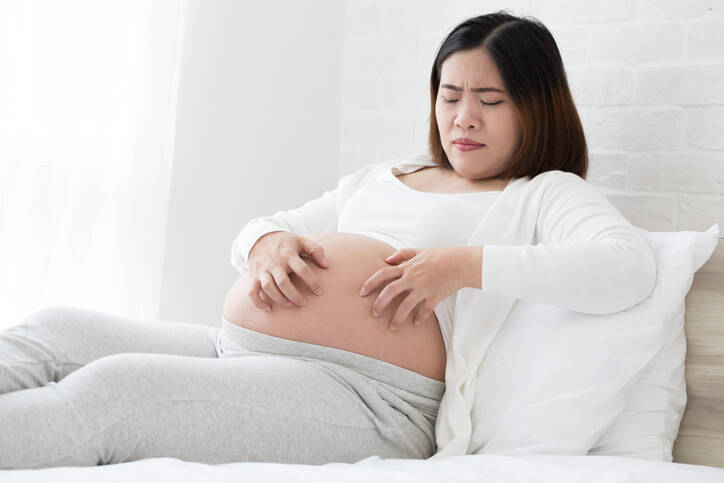Itchy skin in pregnancy? What causes burning skin and what helps?

Pregnancy is for many women one of the most beautiful periods of life. And even though it is accompanied by many inconveniences. One of them is itching of the skin. The cause can be harmless changes in the body, but also a serious disorder.
Article content
Can itchy skin and rashes be a sign of a serious problem?
What are the non-serious causes it commonly has?
What helps with this condition?
Many women complain of itchy skin during pregnancy. Itching (technically pruritus) most often occurs in the area of the growing belly, but also elsewhere on the body. You should be especially alert if the itching is unbearable. It may be a serious symptom.
Common causes of itchy skin in pregnancy
There can be several reasons for the unpleasant itching sensation. Pregnancy is accompanied by many changes. Increased sweating, swelling or tight skin are common in pregnant women. These causes of itchy skin are encountered by almost every pregnant woman.
Tummy growth
As the baby grows, so does the belly of the mom-to-be. The connective tissue and connective fibers in the skin stretch microscopically, causing a feeling of dryness and itching.
Women who have put on weight during pregnancy complain of itching more often. This is due to excessively stretched skin, which causes an irritating feeling of tension and itching.
Sweating
During pregnancy, sweating itself is an unpleasant affair. Sweat irritates the skin and is the cause of unpleasant itching.
The itchiness that is caused by sweat makes trouble especially in the skin folds. These places are more prone to burning and thus irritation. It is also an ideal place for various bacteria to breed.
The solution is to maintain hygiene and wear clothes made of natural material that is light, breathable and allows sweat to evaporate.
Allergies
An allergic reaction is also one of the possibilities that can cause itching. It is usually accompanied by skin manifestations, especially redness or small rashes.
Never underestimate an allergy. Not only in pregnancy, consult your doctor if you see signs of an allergy. In more serious cases, call for emergency medical help.
You may also be interested in articles about lower abdominal pain in pregnancy or the presence of protein in the urine during pregnancy.
How to relieve common itchy skin in pregnancy?
Although itching is an unpleasant symptom, try to avoid scratching too much. Scratched and irritated skin easily becomes an entry point for infection. This can pose a risk to both mother and fetus.
Anti-itch cream, massage and exercise
Gentle superficial massage and creaming of the skin can relieve uncomfortable itching. In this way, you can relieve the itching of tight skin. You will also reduce the risk of skin tears and prevent stretch marks.
There are also special creams for pregnant women that are easy to spread and relieve itching. It is advisable to spread the cream in the tummy area, in a clockwise direction. This will also improve digestion and promote the functioning of the lymphatic system.
Physical exercise also has a very positive effect. It improves the blood supply to the skin, thus preserving its elasticity and significantly relieving the itching sensation.
If the itching is caused by an allergy to pollen, it is advisable to take a shower after each walk to get rid of pollen residues. It is also necessary to wash clothes and shoes.
Read also the articles.
Eating in pregnancy for two?
With proper nutrition and a balanced diet, you will prevent not only health complications, but also excessive weight gain. The skin becomes less tight and does not produce such a strong itching sensation.
It is often said that a pregnant woman should eat for two. Avoid this advice. Include a balanced, varied and healthy diet in your diet. Food should be twice as healthy, not twice as big.
When is itching in pregnancy a serious problem?
If the itching becomes unbearable, it is necessary to be alert. The reason may be the so-called intrahepatic cholestasis. Although there is no danger to the mother, it may be a harbinger of certain risks and dangers for the baby.
Intrahepatic cholestasis in pregnancy is a disease whose origin has not yet been fully elucidated. It is probably related to the action of the hormones estrogen and progesterone on the liver cells. The liver and gallbladder malfunction and bile acids are secreted into the blood. It is characterised by severe itching and high levels of bile acids in the blood.
If you experience any unusual problems, contact your doctor. This is because there may also be other diseases in pregnancy. Examples are infectious hepatitis, viral infections, toxic liver damage, pre-eclampsia or HELLP syndrome.
Around 10% of patients develop a mild yellowing of the skin. Itching on the palms and soles is a typical symptom, but it can occur elsewhere on the body. The irritation worsens especially in the evening.
The skin is not initially reddened and no other changes to the skin are apparent. It is only as a result of severe scratching that redness, irritation or other injuries occur.
Unpleasant itching and irritation of the skin often leads to sleep disturbances, fatigue and mental exhaustion.
The pregnant woman is neither at risk of liver failure nor otherwise at risk of death. After childbirth, there is a spontaneous resolution of difficulties and correction of laboratory results.
However, there are risks to the foetus. The bile acids pass through the placenta and are toxic to the foetus. The higher the bile acid levels, the greater the risk to the foetus.
In pregnant women, bile acid levels are naturally elevated. Bile acid levels up to 11 micromol/l are considered normal. Bile acid concentrations above 40 micromol/l are considered high risk.
Possible causes of itching in pregnancy:
| Common causes of itchy skin |
| itching can be relieved by using creams, exercise, etc. |
| serious causes of itchy skin |
| itching becomes unbearable, professional help required |
What is the risk to the baby in intrahepatic cholestasis
One of the possible threats to the baby is that the baby inhales meconium. Meconium (also smolka) is the name given to the baby's first stool. It is green in colour and contains amniotic fluid, mucus, dead skin cells and so on. That is, anything that the baby may have swallowed while living in the womb. Normally, meconium is expelled sometime in the first few days of the baby's life.
The increased concentration of bile acids during pregnancy causes increased bowel movements in the fetus. Their contents can get into the amniotic fluid, which becomes cloudy. We're talking about so-called cloudy or green amniotic fluid.
Normally, the baby will take its first breath outside the amniotic fluid, after the head is born. However, there are situations where the baby is forced to breathe earlier. The meconium in the amniotic fluid is a risk that the baby will inhale it. This can happen before or during labour.
The presence of meconium in amniotic fluid does not immediately mean that the baby will inhale it. However, it is a serious risk.
Meconium can also cause an acute contraction of the umbilical vein, leading to a lack of oxygen for the fetus.
Another threat is the effect of bile acids on the baby's heart. These acids can cause heart rhythm disturbances and thus intrauterine fetal demise.
As a result of all these and other complications, there is a risk of premature birth or respiratory insufficiency syndrome.
Read also about other serious complications in pregnancy, such as pre-eclampsia.
Treatment of intrahepatic cholestasis in pregnancy
Treatment procedures depend on the age of the fetus and the level of bile acids. It is important to achieve a reduction in bile acid levels so that the delivery date can be approached and the risk to the fetus can be reduced.
Ursodeoxycholic acid is mainly used to treat intrahepatic cholestasis. Its administration is safe for the mother and the unborn child. Other therapeutic agents such as S-adenosyl-L-methionine can also be added to the treatment.
The administration of liver protection drugs or dietary measures is not usually necessary. Liver failure is not a risk for the expectant mother and the condition is completely corrected after delivery.
A mild form of intrahepatic cholestasis
The mild form is defined as a total bile acid level between 20 and 40 micromol/l. Treatment is initiated with ursodeoxycholic acid. Physical rest and a sparing regimen are recommended. Pregnant patients are followed up as outpatients, usually at weekly intervals.
The fetus is also monitored and checked regularly. In this mild form, there are usually no complications. Therefore, pregnancy is usually not terminated before the 38th week of pregnancy. Depending on the patient's condition and laboratory values, labour is induced no later than the due date.
Severe form of intrahepatic cholestasis
The severe form is when the total bile acid values are above 40 micromol/l. Higher doses of ursodeoxycholic acid are administered, to which other necessary drugs are added.
Patients are hospitalized and monitored. Bile acid levels are usually checked twice a week. The fetus is also monitored regularly by ultrasound.
In the severe form, the risk of complications increases with the duration of the pregnancy. It is therefore recommended to terminate the pregnancy after 37 weeks. In some cases, earlier termination may be considered.
Interesting resources










